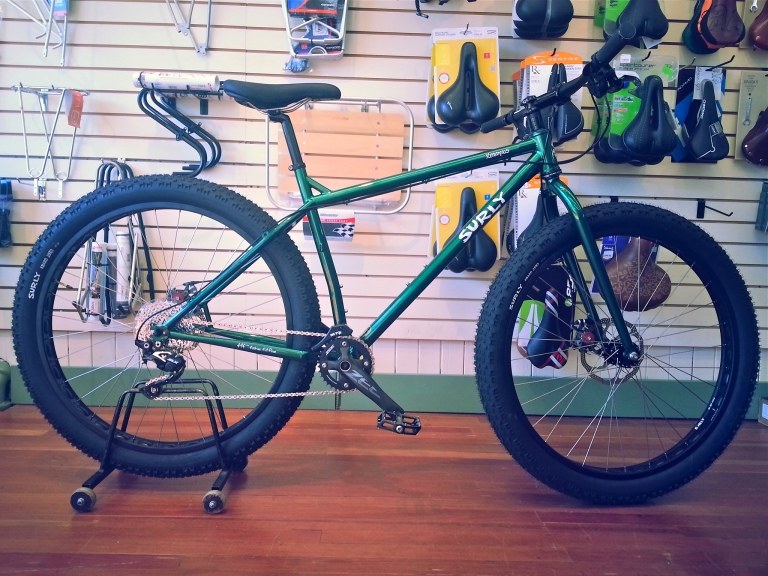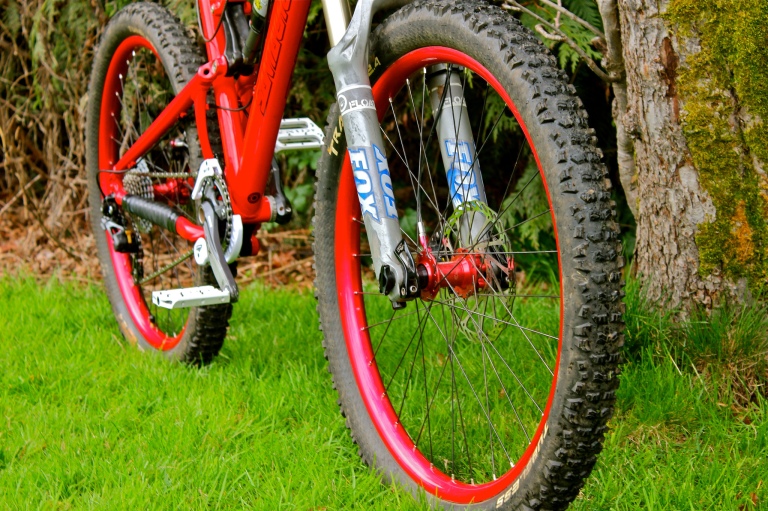
I got one of the first production fatbikes and did get the first production 29+ bike. So I am an early adopter of new technology when I can see some solid reasons why it would benefit me. I am also not a “new is better!” zealot. I’ll drop something as fast as I will try it if it turns out it’s not all I thought it was going to be.
With plus tires all the rage these days I figured it was a good time to throw some of my thoughts about wide rubber onto this blog.
I have used all the major tire options extensively and one of the most over used and incorrect statements I read online during the current plus tire obsession phase in the MTB media is that the wider the tire the more traction you get.
In fact for some important riding situations [slick surfaces] the lower ground pressure of wider tires pushes the knobs of the tire into the ground with less force resulting in less traction than a skinny tire at higher pressures because the knobs can’t get “through” the slick surface.
This is compounded by the fact that many if not most wider tires use lots of smaller less aggressive knobs to keep weight in check with the assumption that because the tire is wider and lower pressure the many small knobs will add up to lots of traction.
Where I live in the PNWet throughout the winter slick roots, mossy rocks, wet soil and mud provide exactly the type of traction challenges that fatbike and plus tires fail at. Come dry weather they would provide excellent traction, but that’s also when skinny tires provide more traction than you can use.
That’s why despite being an early adopter of both fat and plus tires my day-to-day trail bike rolls along on 2.4″ tires.

For exploring and mixed surface touring I do like my 29+ tires because of the amazing roll through of the very tall wheel and the way the wider tire adapts to varying conditions really well [except as noted above]. On balance it’s a win for me, but I don’t tour the PNWet in winter.
For soft conditions like sand and snow wide tires work really well to keep you floating on top of the surface. Wide tires also provide a lot of stability once they start rolling which makes some people more comfortable while other people don’t like the effort required to change direction. The larger volume makes for a comfortable ride on a rigid/hardtail bike at slow to moderate speeds.
If you like to ride aggressively and push your tires down into turns [especially berms] the wider low pressure tires deform much more easily due to low pressures and less structure to the sidewall casings to save weight. This puts a limit to the performance you can get from a wider tire vs. a skinny tire. The weight savings consideration for bigger tires has also led to less robust casings that are damaged more easily by sharp rocks.
As I think about the points above it becomes clear that when you look at fat tires [4″-5″], plus tires [2.8″ -3.5″] and skinny tires [2.1″-2.4″] there are specific situations where one is a clear winner and other situations where more than one option works well. Appreciating the right tool for the job is the way to get the most from your bike and avoid disappointment.

Where I am at with all these tires…
Fatbikes
- they are great for snow, sand and other soft conditions
- crappy for PNWet winter conditions
- I don’t have soft conditions locally so I don’t have a fatbike
29+
- I love 29+ for rolling through rough terrain on a hardtail/rigid bike
- Gives a bit of float and deals with varied surfaces well
- crappy for PNWet winter conditions
- not great for fast aggressive riding
- I use them for touring on my Krampus where roll through is important and I am not riding at my limit carrying camping gear
- I never know what’s around the next bend and appreciate the sure-footedness of the wide tire
27+
- I haven’t used them
- I probably won’t get a chance to try them out
- Can be retro-fitted to some older 29er frames
- Some new 29er FS designs are 29er skinny or 27+
Skinny
- a true 2.4″ tire on a 35mm rim works very well for me on a FS bike
- I get a durable tire with tons of traction summer and winter
- reasonable weight, cost and excellent availability
- very versatile
- poor floatation on soft ground
- this is my go to tire for day-to-day trail riding
When I buy my next bike it will be a 29er with room for 2.4″ tires and really short chainstays. If it can also fit plus tires [either 27+ or 29+] that’s great, but I won’t let that steer my choice. For where I live and how I ride the tall 29er wheel with 2.4″ rubber on a 35mm will work very well.
Hi Vik I like your blog and particularly enjoy the reviews. I know you use a Rohloff IGH on your bikepacking rig. Would you use a Rohloff on your “regular” trailbike? What would you see as the pros and cons? They recently came out with a few new models with thru axles and varoius hub widths AND there is now a gear box that uses sram shifters which sounds pretty exciting to me. How much of a weight gain would you expect to have by adding a Rohloff + necessary parts and dropping the traditional drivetrain? Thanks!
LikeLike
Hi John. Good question. I answered it here:
https://vikapprovedblog.wordpress.com/2016/02/20/rohloff-for-a-mountain-bike/
LikeLike
Thanks Vik I’m honored!
LikeLike
This is great info especially for riders who have not yet experienced all of these tire sizes or varied types of terrain. (Thanks for taking the time to post this Vik) FWIW I am a Krampus rider as well and 29+ tires have really made a big difference for me. While I love the look of even fatter tires, every time I hit the trail I feel like my 29+ tires are fat enough. I do see true fat tires being a better application for very loose/deep snady/snowy terrain. It is so cool to see these sizes evolving right in front of us these days. Where i live in central Texas there is no sand and no snow so + sized tires are a clear winner here. I have recently installed a cheap modified rockshox fork on my krampus which has also been great as well. While I still look for ways to lighten everything, I don’t know if I could go back to rigid. I had a chance to ride a lauf fork recently. WOW that thing is great. Considering trading one of my children for one. Another thing I like about 29+ is how much more forgiving they are while overlanding/off trail riding and encountering big rocks or holes that cannot be seen that would normally stop skinny tires in their tracks. 29+ just barrels through this stuff and makes it a great application for braving un-ridden terrain.
LikeLike